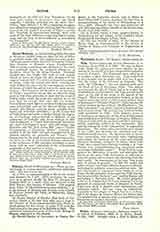
Victor Vitensis
An African bishop of the Province of Byzacena (called Vitensis from his See of Vita), b. probably about 430

Victor Vitensis, an African bishop of the Province of Byzacena (called VITENSIS from his See of Vita), b. probably about 430. His importance rests on his: “Historia persecutionis Africane Provincise, temporibus Geiserici et Hunirici regum Wandalorum”. This is mainly a contemporary narrative of the cruelties practiced against the orthodox Christians of Northern Africa by the Arian Vandals. Formerly divided into five books, this work is now usually edited in three, of which the first, dealing with the reign of Geiseric (427-77), is derived from the accounts of others, while the second and third, covering the reign of Huneric, are a strictly contemporary account of events, of which the author was in the main an eye-witness. No exception can be taken to the accuracy of Victor‘s narratives, except that at times he exaggerates, but when allowance is made for the stress of feeling under which the work was written, it can be seen that he records little that did not happen. Victor throws much light on social and religious conditions in Carthage and on the African liturgy of the period. His history contains many valuable documents not otherwise accessible, e.g. the Confession of Faith drawn up for the orthodox bishops by Eugenius of Carthage and presented to Huneric at the conference of Catholic and Arian bishops in 484. Two documents: a “Passio beatissimorum martyrum qui apud Carthaginem passi sunt sub impio rege Hunerico (die VI. Non. Julias 484)” and a “Notitia Provinciarum et Civitatum Africk”, formerly appended to all the MSS. and now incorporated in the printed editions, are probably not Victor‘s. The former may be the work of one of his contemporaries; the latter is a list of the Catholic bishops summoned to the conference of 484, arranged according to provinces, with an exact indication of the ecclesiastical geography of that portion of Africa.
PATRICK HEALY

